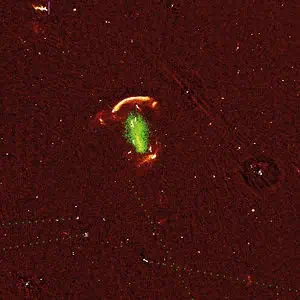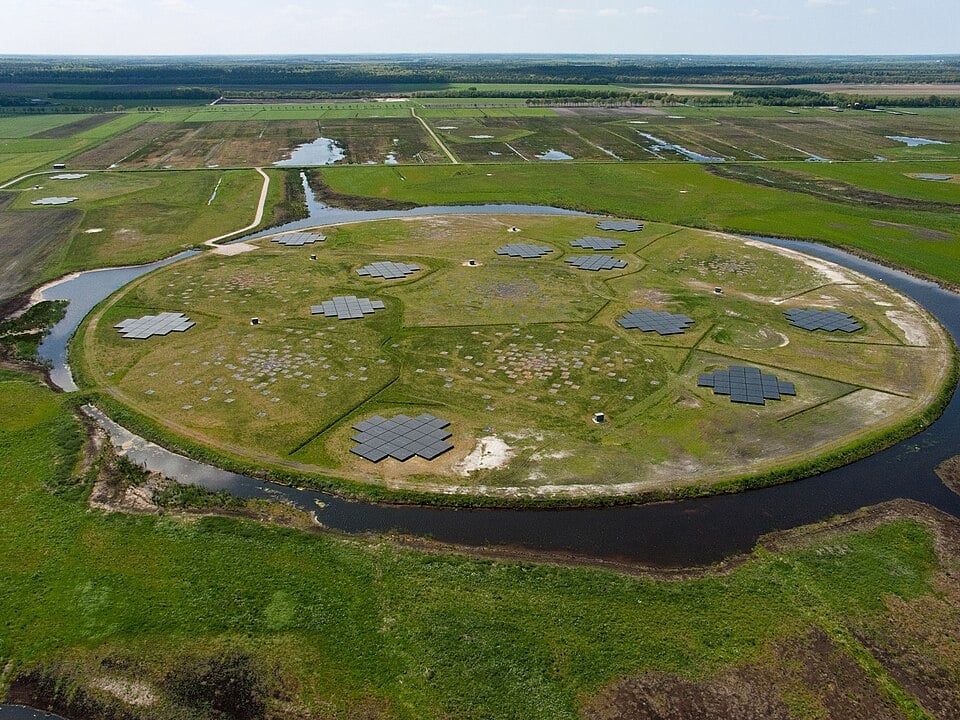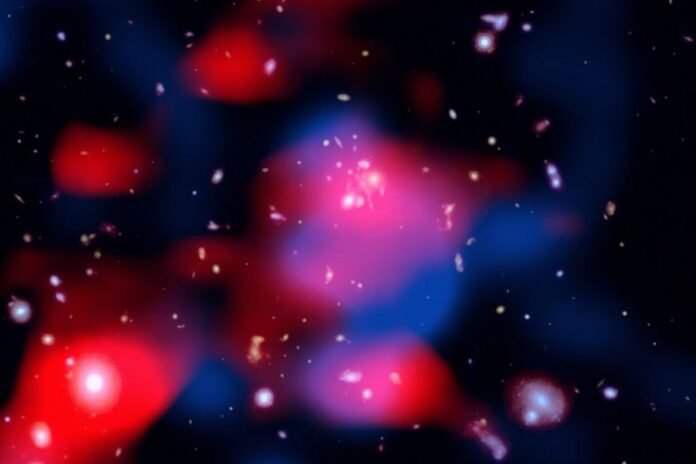If you could see the Universe through a radio-wave “eye”, you’d detect mini-halos of relativistic particles creating radio emissions around some galaxy clusters. Astronomers long figured those halos are relative “recent” happenings in the nearby Universe and didn’t occur in the early epochs of cosmic history. That’s all changed now that the Low Frequency Array (LOFAR) radio observatory in Europe has revealed newborn galaxies in the early Universe already surrounded by a halo of particles. It’s a rare look at what such clusters were like soon after they formed.
Clusters of galaxies are known to sport spectacular diffuse radio sources. These can extend over distances ranging from 100 kpc (326,156 light-years) to several Mpcs (millions of light-years). These sources aren’t necessarily tied to individual galaxies. Instead, they trace the presence of synchrotron emission from large-scale magnetic fields and relativistic particles within the intracluster environment-essentially in the regions between cluster galaxies.
Université de Montréal’s Julie Llavacek-Larrondo co-led a team with Durham University’s Roland Timmerman to observe the distant early Universe and found that distant, early galaxy clusters have had these high-energy particle shrouds for almost all their existence. The galaxy cluster they studied, called SpARCS104922.6+564032.5, turns out to be the most distant cool-core cluster identified to date, at a distance of 10 billion light-years. That makes its halo the most distant mini-halo ever seen. The team used LOFAR to detect 120–168 MHz emissions from the scene. “It’s astonishing to find such a strong radio signal at this distance,” Timmerman. “It means these energetic particles and the processes creating them have been shaping galaxy clusters for nearly the entire history of the universe.”
Taking a Rare Look at Early Galaxy Clusters
The SpARCS104922.6+564032.5 mini-halo is a cloud of highly energetic charged particles. It fills the vacuum between galaxies in the cluster and emits radio waves that can be detected from Earth. The mini-halo’s existence should help astronomers understand more about this early epoch, as well as how energy moves through galaxy clusters.
The astronomers described this mini-halo discovery as a rare look at what galaxy cluster environments were like just after they formed. It’s now clear that halos of high-energy particles in the halos have existed for billions of years longer than astronomers thought. Their presence definitely allows scientists to track their origins and paths through the cluster. LOFAR has also looked at other distant, early clusters to characterize their shapes and emissions.
 The most sensitive image of the Sausage cluster observed with the LOFAR HBA antennas at 150 MHz. The cluster shows two opposing giant radio relics created through galaxy cluster mergers. The merger heats up the intra-cluster gas to extremely hot plasma emitting X-rays (green). Here, particles (e.g. electrons) are accelerated to very high energies. The rest of the resolved sources are mostly radio galaxies hosting an active super massive black hole. Credit: Duy Hoang (Leiden), Tim Shimwell (Leiden), Andra Stroe (ESO), Reinout van Weeren (Harvard), Georgina Ogrean (ESO) and Huub Rottgering (Leiden) for the LOFAR surveys team
The most sensitive image of the Sausage cluster observed with the LOFAR HBA antennas at 150 MHz. The cluster shows two opposing giant radio relics created through galaxy cluster mergers. The merger heats up the intra-cluster gas to extremely hot plasma emitting X-rays (green). Here, particles (e.g. electrons) are accelerated to very high energies. The rest of the resolved sources are mostly radio galaxies hosting an active super massive black hole. Credit: Duy Hoang (Leiden), Tim Shimwell (Leiden), Andra Stroe (ESO), Reinout van Weeren (Harvard), Georgina Ogrean (ESO) and Huub Rottgering (Leiden) for the LOFAR surveys team
If these mini-halos truly do exist (and the evidence is strong), then how did they form? There are a couple of different ideas to explain them. One invokes black holes and the other uses cosmic particle collisions to explain the halos. The black hole idea suggests that supermassive black holes in the hearts of the cluster’s galaxies are sending out massive streams of high-energy particles. That sounds plausible, based on what we know about such black holes and their feeding habits. They ingest material via their accretion disks, which gets superheated as it spirals. That action releases particles and radiation. However, it’s still not clear just how the particles could move away so quickly and form a mini-halo–remain so energetic.
The cosmic particle collisions theory suggests that when charged particles in the cluster environment collide at near-lightspeed velocities, they smash apart. That creates additional showers of such particles that eventually make up the mini-halo.
LOFAR and Next-generation Radio Arrays
The detection of these mini-halos using LOFAR is a big step forward in radio astronomy studies of the early Universe. The team’s findings provide a pathway for other arrays, such as SKA (Square Kilometre Array) and ngVLA (next-generation Very Large Array) to dig deeper into the early Universe.
 A portion of the LOFAR telescope located near Exloo, in the Netherlands. The entire array extends across parts of Europe. Credit: LOFAR / ASTRON
A portion of the LOFAR telescope located near Exloo, in the Netherlands. The entire array extends across parts of Europe. Credit: LOFAR / ASTRON
LOFAR is the largest radio telescope operating in the lowest frequency radio in the radio astronomy world. Its receivers are scattered across most of Europe, with most of them studying the sky in the Netherlands. Among other things, it was built to study the early Universe, including emissions from the earliest stars and galaxies. Astronomers also use it to study pulsars, active galactic nuclei, events in nearby galaxies, and other short-lived “radio transients” such as fast radio bursts.
One of LOFAR’s primary aims is to help astronomers understand how and where objects in the Universe accelerated the highest-energy particles. Observations of the mini-halos in the early Universe help identify the sources and raise more questions about the origin and evolution of structure in the cosmos. Other LOFAR science ranges back to the ages of the first stars, and even seeks to dig into the Epoch of Reionization. That’s the period when neutral gas in the infant Universe became ionized by the first stars and galaxies. The emissions from those eras show up here at Earth in radio frequencies especially detectable by LOFAR.
For More Information
Discovery of ‘Mini Halo’ Points to How the Early Universe Was Formed
Discovery of Diffuse Radio Emission in a Massive z=1.709 Cool Core Cluster: A Candidate Radio Mini-Halo
LOFAR


